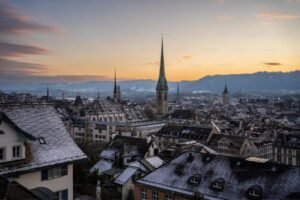The Grand Duchy is a treasure trove of unique experiences, offering a little something for everyone. From its picturesque architecture and captivating history to its sprawling nature reserves and delectable chocolate, this small country draws visitors with its undeniable charm. As you wander through its quaint streets, you’ll discover a world where the diversity of cultures and traditions come together in perfect harmony.
A place where enchanting castles rise majestically from the lush green hills, each telling a story of a bygone era. These famous historical structures are among the main attractions, capturing the imagination of every traveler. The finance sector, too, plays a pivotal role in shaping the identity of this intriguing nation, making it a hub of economic activity.
If you seek solace in the tranquil embrace of nature, the Grand Duchy will not disappoint. Its verdant landscapes and serene forests offer a peaceful retreat from the hustle and bustle of modern life. As you explore these natural wonders, you’ll find that the country’s true magic lies in its ability to seamlessly blend the old with the new, creating a tapestry of experiences that are as memorable as they are enchanting.
Exploring the Grand Duchy’s Unique Identity
The small but mighty Grand Duchy is a place where tradition meets modernity, creating a distinctive identity that fascinates many. Its rich history and cultural diversity are core elements that shape the nation. Here, you’ll find a blend of influences that makes this place truly one-of-a-kind.
One of the main attractions is the impressive castles scattered across the countryside. These historic structures stand as guardians of the past, each telling tales from different eras. The architecture, a mix of medieval and contemporary styles, adds to the unique charm of the region.
The financial sector is another significant aspect of this nation’s identity. As a leading hub for global finance, it attracts professionals from all over the world, contributing to its multicultural environment. The diversity here is not only cultural but also economic, making it a vibrant place for business and innovation.
Nature lovers will appreciate the scenic landscapes that offer a stark contrast to the bustling cities. The lush greenery and serene parks provide a natural respite, perfect for those seeking tranquility. These natural wonders make the Grand Duchy a haven for outdoor enthusiasts.
And let’s not forget the culinary delights, especially the chocolate, which is as rich and diverse as the country itself. Famous for its quality and flavor, it is a must-try for any visitor.
In conclusion, the Grand Duchy is a fascinating blend of history, culture, and modernity. Its unique identity shines through its attractions, from castles to finance, nature to chocolate. Each element adds to a tapestry that is as intricate as it is inviting.
Luxembourg’s Rich Cultural Heritage: From Castles to Cathedrals
The Grand Duchy boasts a unique fusion of history and diversity, evident in its stunning architecture and rich cultural landmarks. Known for its medieval castles and awe-inspiring cathedrals, the country offers a picturesque journey through time.
Castles: Guardians of History
The castles are main attractions, with each structure telling a story of the past. Their majestic towers and fortified walls create a fairy-tale atmosphere, perfect for exploring the duchy’s storied history.
- Vianden Castle: Of all the castles, this one is particularly famous. It stands as a symbol of grandeur, perched high above the town.
- Bourscheid Castle: Surrounded by nature, this castle is a must-see for those who appreciate both history and picturesque landscapes.
- Beaufort Castle: Known for its intriguing blend of medieval and Renaissance architecture.
Cathedrals: Spiritual Marvels
The architectural diversity of the cathedrals makes them remarkable. Each offers a glimpse into the spiritual and cultural evolution of the region.
- Notre-Dame Cathedral: Famous for its gothic architecture and serene interiors.
- Saint Michael’s Church: The oldest religious site, showcasing a mix of Romanesque and Baroque styles.
A visit to this charming nation would be incomplete without indulging in its delicious chocolate, another facet that makes it unique. Whether you are drawn by finance or its cultural treasures, the duchy offers something for everyone, making it a perfect destination for those with a love of history, nature, and culinary delights.
Financial Hub of Europe: Economic Power of a Small Nation
Situated in the heart of Europe, this grand duchy stands as a beacon of financial might, offering a unique blend of history, nature, and architectural marvels. Its evolution into a financial powerhouse is a story of strategic development and cultural diversity.
- Rich History: Known for its history, this nation transformed from a small duchy to a grand financial center. The legacy of its past is visible in its preserved castles and historic sites.
- Diverse Economy: The economic structure is diverse, with finance as the main driver. This diversity ensures resilience and stability, attracting global investors.
- Financial Sector: The financial services are famous for their sophistication and innovation. This sector includes banking, investment funds, and insurance.
- Architectural Attractions: Famous for unique architecture, the combination of modern skyscrapers and ancient buildings makes it a visual delight.
- Natural Beauty: Nestled among rolling hills and dense forests, the natural attractions provide a serene backdrop to its urban success.
- Cultural Diversity: The population’s cultural diversity contributes to a vibrant community, adding a rich layer to its social fabric.
The grand duchy’s ability to maintain economic prowess while preserving its rich heritage is what makes it stand apart. Its strategic position and commitment to innovation continue to define its role in the global economy.
Natural Wonders: The Scenic Beauty of Ardennes
The Ardennes, with its mesmerizing beauty, stands as a symbol of the stunning natural diversity found in the Grand Duchy. This region attracts countless admirers who seek a connection with nature through its unique attractions.
The allure of the Ardennes lies in its blend of majestic landscapes and historical architecture. As visitors explore, they discover a tapestry of lush forests and winding rivers. The hills and valleys provide a picturesque backdrop for outdoor adventures, making it a beloved destination for those who cherish the great outdoors.
Those who venture into this region can expect to encounter:
- Charming castles that whisper the history of bygone eras.
- Enchanting villages that showcase the region’s unique architecture.
- Trails that wind through serene nature, perfect for hiking enthusiasts.
The Ardennes is also renowned for its culinary delights. The area offers a taste of exquisite chocolate that has become a symbol of the region’s rich cultural heritage. This combination of natural beauty and culinary tradition forms the essence of what makes Ardennes famous within the Grand Duchy.
In the heart of this wonderful region, the Ardennes continues to captivate all who experience its charm, offering a perfect blend of history and natural splendor.
Culinary Delights: What to Taste in the Grand Duchy
The cuisine of the Grand Duchy is a fascinating blend of tastes and traditions, influenced by its rich history and diverse cultural tapestry. This unique fusion makes the country a culinary paradise for those eager to explore new flavors.
Main Attractions of the Culinary Scene
- The Famous Bouneschlupp: A traditional green bean soup, often served with potatoes and bacon, showcasing the rustic nature of the region’s cooking.
- Judd mat Gaardebounen: Smoked pork neck with broad beans, a hearty dish that reflects the robust tastes favored by locals.
- Quetschentaart: A sweet delight made from plums, capturing the essence of the country’s baking traditions.
- Luxembourg’s Unique Chocolate: Known for its exquisite quality, the chocolate here offers a journey into the world of fine desserts.
Exploring the Diversity of Flavors
- Diversity in Wine: The Moselle Valley is renowned for its exceptional wines, offering crisp whites that complement the regional dishes beautifully.
- French Influence: Experience the delicate pastries and sophisticated dining that highlight the French impact on the local gastronomy.
- German Roots: Savor hearty sausages and comforting stews, reflecting the culinary traditions shared with its neighboring country.
The culinary traditions of the Grand Duchy are not just about taste, but also a reflection of its history and culture. Whether you’re indulging in a famous dish or savoring a unique wine, the offerings here are truly remarkable.
Luxembourg’s Multilingual Society: A Case Study in Diversity
The Grand Duchy of Luxembourg is a unique example of cultural and linguistic diversity. This small nation, nestled in the heart of Europe, manages to harmoniously blend multiple cultures and languages, creating a rich tapestry of traditions and modern influences. It is home to a variety of attractions that draw visitors from around the world, including its famous castles and distinctive architecture.
Languages and Their Role in Society
The multilingual nature of this country is one of its defining features. Here, three official languages coalesce to form the backbone of its society:
- Luxembourgish: The national language, reflecting the country’s rich history and cultural identity.
- French: Widely used in the judiciary and administrative sectors, adding a layer of sophistication and elegance.
- German: Commonly seen in media and education, offering a connection to historical roots and neighboring regions.
This linguistic diversity is not just a matter of communication but a significant part of the nation’s identity. It shapes everyday interactions and fosters a sense of unity amidst diversity. Residents switch effortlessly between languages, showcasing their adaptability and open-mindedness.
Integration and Culture
The harmonious integration of various communities also extends to the cultural realm. This is evident in the country’s thriving arts scene, where international influences intermingle with local traditions. Moreover, the culinary landscape reflects a blend of flavors, from exquisite French cuisine to rich German dishes, enhanced by the presence of world-renowned chocolate.
Luxembourg’s commitment to nurturing diversity is apparent in its vibrant educational system. Schools teach in multiple languages, preparing students for a globalized world and highlighting the importance of linguistic proficiency.
Despite its small size, this grand duchy is a powerhouse in the finance sector, further adding to its global significance. Yet, amidst the modernity, nature remains an integral part of life, with picturesque landscapes offering a serene retreat from the bustling city life.
In essence, the multilingual society of Luxembourg is a celebration of diversity. It stands as a testament to the power of embracing multiple cultures and languages, making this nation a truly exceptional place.
Question: What is Luxembourg best known for?
Answer: Luxembourg is best known for its status as one of the world’s leading financial centers. The country is home to numerous banks and investment funds, making it a pivotal player in global finance. Additionally, it’s renowned for its blend of cultures and languages, as well as its stunning medieval architecture, particularly in Luxembourg City, which is a UNESCO World Heritage Site.
Question: What makes Luxembourg unique compared to other European countries?
Answer: Luxembourg’s uniqueness lies in its combination of a small size with significant international influence, both economically and politically. It boasts a trilingual culture, with Luxembourgish, French, and German all being official languages. Moreover, Luxembourg’s picturesque landscapes and historical sites, such as the Vianden Castle and the Bock Casemates, add to its distinctiveness.
Question: What are some main attractions visitors should not miss in Luxembourg?
Answer: Visitors to Luxembourg should not miss the Grand Ducal Palace, the official residence of the Grand Duke, which offers a glimpse into the country’s royal heritage. The Mullerthal Trail, also known as ‘Little Switzerland,’ is perfect for nature enthusiasts, offering stunning hikes through rocky landscapes. The Luxembourg American Cemetery and Memorial is another significant site, honoring American soldiers who fought in World War II.
Question: What is Luxembourg famous for in terms of culture and traditions?
Answer: Luxembourg is famous for its rich cultural traditions, including festivals like Schueberfouer, an annual fair with a history dating back to 1340. The country also celebrates National Day with enthusiasm, featuring fireworks and parades. In terms of culinary traditions, dishes like Judd mat Gaardebounen (smoked pork with broad beans) highlight Luxembourg’s culinary heritage.
Question: How does Luxembourg’s economy stand out on the global stage?
Answer: Luxembourg’s economy is particularly notable for its high GDP per capita, one of the highest in the world. Its financial sector, especially in banking and investment funds, plays a critical role globally. The country is also a founding member of several international organizations, including the European Union, which further underscores its economic significance.
Question: What is Luxembourg best known for?
Answer: Luxembourg is widely recognized for being one of the world’s smallest countries and a significant financial hub in Europe. It is home to numerous banks and financial institutions, contributing to its reputation as a global financial center. Additionally, Luxembourg is known for its high standard of living and multilingual population.
Question: What are the main attractions of Luxembourg that tourists should visit?
Answer: Visitors to Luxembourg are often drawn to its historical and architectural landmarks. The Old Quarter of Luxembourg City, a UNESCO World Heritage Site, offers picturesque views with its ancient fortifications and charming streets. The Bock Casemates, an underground network of tunnels, attracts history enthusiasts. In addition, the Vianden Castle and the Mullerthal Trail, known as Luxembourg’s Little Switzerland, are must-see attractions.
Question: Why is Luxembourg considered an important country despite its small size?
Answer: Despite its small size, Luxembourg holds significant political and economic influence on the global stage. It is one of the founding members of the European Union and hosts several key EU institutions, including the European Court of Justice. The country’s robust economy, driven by banking and finance, technology, and logistics sectors, also contributes to its importance.










